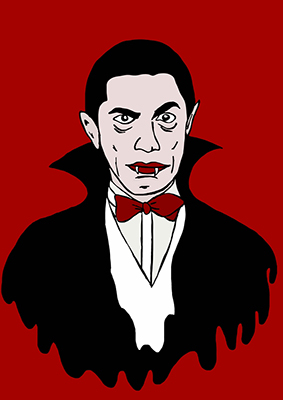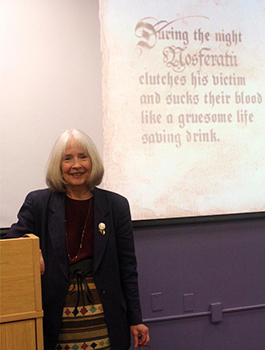Our Vampires, Ourselves
Rutgers professor who teaches courses on these undead creatures explains their staying power

‘If vampires can morph into physical beings, then they can morph to address cultural problems that arouse our anxieties. They are a potent symbol and will be around as long as humans are anxious.’– Dianne Sadoff
For 15 years, English professor Dianne Sadoff has been teaching about vampires, the blood-sucking undead creatures who have been haunting us for more than a century.
She uses Bram Stoker’s Dracula, the 1897 horror novel, as the groundwork to connect literature and film. The students in her classes don’t just get to read books; they watch Dracula movies. Her undergraduate signature course, “Our Vampires, Ourselves,” has become so popular that other faculty members and graduate students wanted pointers emulating her style.
At the request of Rutgers British Studies Center, she began a three-session master class in September to show other faculty members and graduate students how to meld cinema and humanities in the courses they teach or will teach.
Sadoff said she has long been interested in literature that’s eternal: Austen, Dickens and, yes, Dracula – and she’s not alone. The fascination with vampires doesn’t seem to die. The Twilight trilogy, HBO’s True Blood and CW’s Vampire Diaries television series are pop culture’s latest fascination – a fascination, Sadoff says, that may never end.
“If vampires can morph into physical beings, then they can morph to address cultural problems that arouse our anxieties,” she says. “They are a potent symbol and will be around as long as humans are anxious.”
The idea for the undergraduate course came to her in 2000 while she was on a date with her now-husband. The couple went to see Shadow of the Vampire, starring John Malkovich as German director F.W. Murnau struggling to make his 1922 classic horror movie Nosfertau that retells the Dracula story.
As Sadoff was watching the movie, she realized there was so much material on vampires that she could spend a semester teaching about their impact on popular culture, enabling her to combine her two areas of expertise: Victorian literature and cinema.
Sadoff said she had long taught about Frankenstein and Dracula in her literature classes but until then she had never considered doing a cinema version of the works. She proposed the course at Miami University in Ohio, where she worked then. When she came to Rutgers in 2006, she brought the course with her. She has been teaching a variation of the course ever since, most recently in the spring.
She eventually published a book on the subject, Victorian Vogue: British Novels on Screen, in 2009.
In the second session of the master class, “Vampings with Dracula: Teaching with Film Across the Humanities,” last week, she showed clips from three movies: Murnau’s silent movie Nosferatu (1922); Werner Herzog’s Nosferatu: Phantom der Nacht (1979); and Francis Ford Coppola’s Bram Stoker’s Dracula (1992).

She led the session with a discussion about the issues of sex and gender system in Stoker’s novel. She said the book is layered with sexual overtones: the blood sucking, the stake in the heart, the creatures of the night.
Aside from the discussing the role of sex in Dracula, Sadoff discussed cinematography: the use of low- and high-angle camera shots in Murnau’s film; the role of sound in Herzog’s movie, such as door creaking or Dracula’s heavy breathing, and the grainy film in Coppola’s movie, designed to show the vampire’s point of view.
Rutgers history professor Seth Koven, who attended Sadoff’s master class, found the discussion on cinematography helpful.
“I love Victorian literature and I wanted to learn how to make bridges between novel and film, to think about the connections and differences; the visual language and sound language of film versus the text that I might normally be thinking about,” Koven said after the Oct. 21 session.
Jesse Hoffman, a fellow at the Honors College, said Sadoff has made vampires seem even sexier than he had thought.
“Vampires aren’t just Twilight; their history is rooted in Victorian literature,” Hoffman said after the master class. “Dianne shows the interaction between literature and the film. It’s a persuasive class. It touches on things that students are interested in but also engages them in a way that opens up this whole new period of literature, history, and film.”
Though Sadoff is retiring next year, she said she still plans to teach her vampire class, continuing to feed our fascination with these beings.
“Frankenstein and Dracula are not scientific beings. They’re imaginary. They’re cyborgs,” she said. “They represent the scientific anxieties we have.”